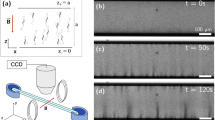Abstract
Convection in a suspension of motile microorganisms with upward drift is studied using nonlinear stability theory. The organisms move with Reynolds number much less than unity and do not leave the fluid. Hence, the condition of zero flux on horizontal boundaries must be imposed and this produces, in linear theory, a critical wave number of zero. For slightly supercritical conditions, a band of small wave numbers is excited. The generic case is not Boussinesq and the onset of motion occurs through a subcritical bifurcation, a result consistent with observation of cultures of microorganisms near the onset of instability. We develop a stationary model for the dense clusters of organisms that form. In this model, the momentum transferred to the fluid by a cluster of organisms interacts with the horizontal boundaries, and the resulting recirculation of the fluid can maintain the integrity of the clusters. The observed spacing of aggregates is consistent with the stationary solution which maximizes the mean cluster volume.
Access this chapter
Tax calculation will be finalised at checkout
Purchases are for personal use only
Preview
Unable to display preview. Download preview PDF.
Similar content being viewed by others
References
Batchelor, G.K. (1956). On steady laminar flow with closed streamlines at large Reynolds number, J. Fluid Mech., 1: 177–190.
Busse, F.H. and Riahi, N. (1980). Nonlinear convection in a layer with nearly insulating boundaries, J. Fluid Mech., 96: 243–256.
Chandrasekhar, S. (1961), Hydrodynamic and Hydromagnetic Stability, Oxford University Press.
Chapman, C.S. and Proctor, M.R.E. (1980). Nonlinear Rayleigh-Bénard convection between poorly conducting boundaries, J. Fluid Mech., 101: 759–782.
Chapman, C.S., Childress, S., and Proctor, M.R.E. (1981), Long wavelength convection between non-conducting boundaries, Phys. Earth Planetary Int., 51: 362–369.
Childress, S. (1966). Solutions of Euler’s equations containing finite eddies,Phys. of Fluids, 9: 866–872.
Childress, S., Levandowsky, M., and Spiegel, E.A. (1975a). Pattern formation in a suspension of swimming micro-oranisms: equations and stability theory, J. Fluid Mech., 63: 591–613.
Childress, S., Levandowsky, M., and Spiegel, E.A. (1975b). Non-linear solutions of equations describing bioconvection, in Swimming and Flying in Nature, Vol. 2., edited by T.Y.-T.Wu, C.J. Brokaw, and C. Brenner, 361–376.
Childress, S. and Peyret, R. (1976). A numerical study of two-dimensional convection by motile particles,J. de Mécanique, 15: 753–779.
Childress, S. and Spiegel, E.A. (1975). Archimedean instabilities in twophase flows,Siam Rev., 17: 136–165.
Depassier, M.C. and Spiegel, E.A. (1981). The Large-Scale Structure of Compressible Convection, Astron. J., 86: 496–512.
Depassier, M.C. and Spiegel, E.A. (1982). Convection With Heat Flux Prescribed on the Boundaries of the System I. Temperature Dependent Material Properties, Geophys. and Astrophys. Fluid Dynamics, 21: 167–188.
Grad, H., Hu, P.N., and Stevens, D.C. (1975). Adiabatic evolution of plasma equilibrium,Proc. Nat. Acad. Sci., 72: 3789–3793.
Hurle, D.T.G., Jakeman, E. and Pike, E.R. (1967). On the solution of the Bénard problem with boundaries of finite conductivity, Proc. Roy. Soc., A296: 469–475.
Kessler, J.O. (1986). Individual and collective fluid dynamics of swimming cells, J. Fluid Mech., 171: 191–205.
Kessler, J.O., Strittmatter, R.P., Swartz, D.L., Wiseley, D.A., and Wojciechowski, M.F. (1995). Paths and patterns: the biology and physics of swimming bacterial populations, Soc. Exp. Biol., 32: 91–107.
Leissa, A.W. (1973). Vibration of Shells, NASA Report SP-288, U.S. Government Printing Office, Washington, D.C.
Levandowsky, M., Childress, S., Spiegel, E.A., and Hutner, S.H. (1975). A mathematical model for pattern formation by swimming microorganisms, J. Protozool., 22: 296–306.
Lin, J. (1979). The Fluid Dynamics of Radiatively Driven Element Separation in Stars. Thesis, Columbia University Physics Department. Loper, D. and Roberts, P.H. (1978). Private communication.
Malkus, W.V.R. (1954). The heat transport and spectrum of thermal turbulence, Proc. Roy. Soc., A 225: 196–212.
Malkus, W.V.R. and Veronis, G. (1958). Finite amplitude cellular convection, J. Fluid Mech., 4: 225–260.
Milewski, P.A. and Keller, J.B. (1996). Three-dimensional Water Waves, Studies in App. Math., 37: 149–166.
Newell, A.C. and Whitehead, J.A. (1969). Finite Bandwidths finite amplitude convection, J. Fluid Mech., 38: 279–303.
Pedley, T.J., Hill, N.A., and Kessler, J. O. (1988). The growth of bioconvectivepatterns in a uniform suspension of gyrotactic micro-organisms, J. Fluid Mech., 195: 233–238.
Plesset, M.S. and Winet, H. (1974). Bioconvection patterns in swimming microorganism cultures as an example of Rayleigh-Taylor instability, Nature, 248: 441–443.
Segel, L.A. (1969). Distant sidewalls cause slow-amplitude modulation of cellular convection, J. Fluid Mech., 38: 208–224.
Swift, J. and Hohenberg, P. C. (1977). Hydrodynamic fluctuations at the convective instability, Phys. Rev. A, 15: 319–337.
Wille, J.J. and Ehret, C.F. (1968). Circulation rhythm of pattern formation in populations of a free-swimming organism, Tetrahymena, J. Protozool., 15: 789–792.
Author information
Authors and Affiliations
Editor information
Editors and Affiliations
Rights and permissions
Copyright information
© 2004 Springer Science+Business Media Dordrecht
About this chapter
Cite this chapter
Childress, S., Spiegel, E.A. (2004). Pattern Formation in a Suspension of Swimming Microorganisms: Nonlinear Aspects. In: Givoli, D., Grote, M.J., Papanicolaou, G.C. (eds) A Celebration of Mathematical Modeling. Springer, Dordrecht. https://doi.org/10.1007/978-94-017-0427-4_3
Download citation
DOI: https://doi.org/10.1007/978-94-017-0427-4_3
Publisher Name: Springer, Dordrecht
Print ISBN: 978-90-481-6526-1
Online ISBN: 978-94-017-0427-4
eBook Packages: Springer Book Archive




